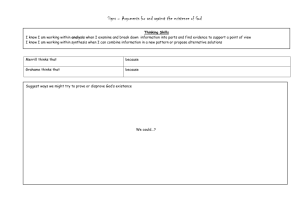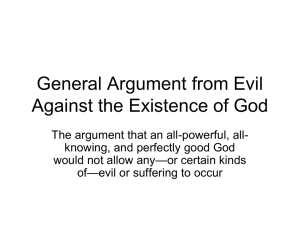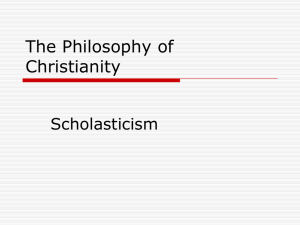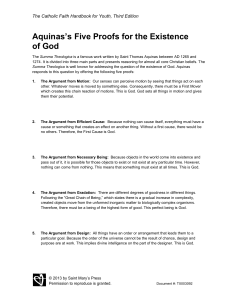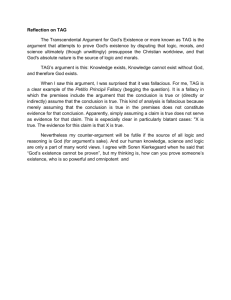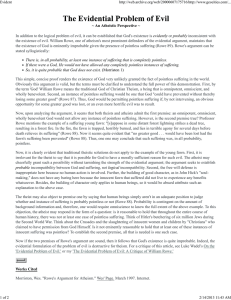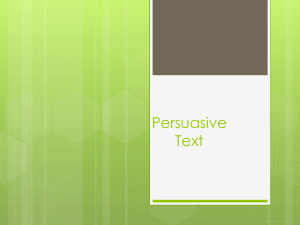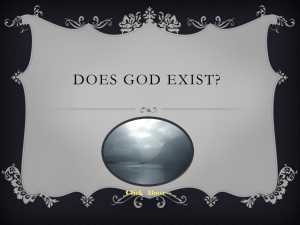Lesson on Rowe
advertisement
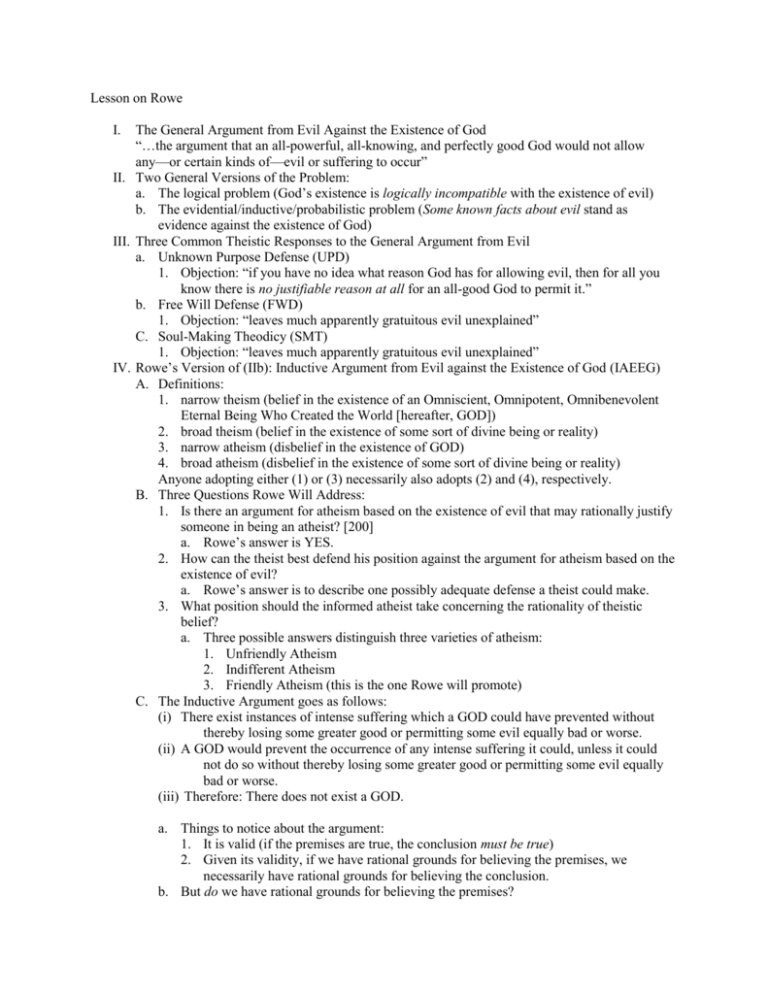
Lesson on Rowe I. The General Argument from Evil Against the Existence of God “…the argument that an all-powerful, all-knowing, and perfectly good God would not allow any—or certain kinds of—evil or suffering to occur” II. Two General Versions of the Problem: a. The logical problem (God’s existence is logically incompatible with the existence of evil) b. The evidential/inductive/probabilistic problem (Some known facts about evil stand as evidence against the existence of God) III. Three Common Theistic Responses to the General Argument from Evil a. Unknown Purpose Defense (UPD) 1. Objection: “if you have no idea what reason God has for allowing evil, then for all you know there is no justifiable reason at all for an all-good God to permit it.” b. Free Will Defense (FWD) 1. Objection: “leaves much apparently gratuitous evil unexplained” C. Soul-Making Theodicy (SMT) 1. Objection: “leaves much apparently gratuitous evil unexplained” IV. Rowe’s Version of (IIb): Inductive Argument from Evil against the Existence of God (IAEEG) A. Definitions: 1. narrow theism (belief in the existence of an Omniscient, Omnipotent, Omnibenevolent Eternal Being Who Created the World [hereafter, GOD]) 2. broad theism (belief in the existence of some sort of divine being or reality) 3. narrow atheism (disbelief in the existence of GOD) 4. broad atheism (disbelief in the existence of some sort of divine being or reality) Anyone adopting either (1) or (3) necessarily also adopts (2) and (4), respectively. B. Three Questions Rowe Will Address: 1. Is there an argument for atheism based on the existence of evil that may rationally justify someone in being an atheist? [200] a. Rowe’s answer is YES. 2. How can the theist best defend his position against the argument for atheism based on the existence of evil? a. Rowe’s answer is to describe one possibly adequate defense a theist could make. 3. What position should the informed atheist take concerning the rationality of theistic belief? a. Three possible answers distinguish three varieties of atheism: 1. Unfriendly Atheism 2. Indifferent Atheism 3. Friendly Atheism (this is the one Rowe will promote) C. The Inductive Argument goes as follows: (i) There exist instances of intense suffering which a GOD could have prevented without thereby losing some greater good or permitting some evil equally bad or worse. (ii) A GOD would prevent the occurrence of any intense suffering it could, unless it could not do so without thereby losing some greater good or permitting some evil equally bad or worse. (iii) Therefore: There does not exist a GOD. a. Things to notice about the argument: 1. It is valid (if the premises are true, the conclusion must be true) 2. Given its validity, if we have rational grounds for believing the premises, we necessarily have rational grounds for believing the conclusion. b. But do we have rational grounds for believing the premises? 1. Consider the second premise: assuming that s is an instance of intense human or animal suffering which a GOD could prevent, let us ask what are the necessary conditions under which it would be the case that a GOD had failed to prevent s. 2. Rowe states this necessary condition as a tripartite disjunction: Either (i) there is some greater good, G, such that G is obtainable by GOD only if God permits s, or (ii) there is some greater good, G, such that G is obtainable by GOD only if GOD permits either sor some evil equally bad or worse, or (iii) s is such that it is preventable by GOD only if GOD permits some evil equally bad or worse. 3. Rowe’s then says that premise (2) of the Inductive Argument is true because on all three construals of its meaning, i.e., (i) or (ii) or (iii) above, if each is true, then (2) is true. 4. Rowe concludes that premise (2) of IAEEG is true and accepted by theists and atheists alike. c. Rowe then considers whether premise (1) of IAEEG is true. 1. He considers the Fawn Burned Alive in the Forest Fire CASE and concludes: a. While we cannot prove that (1) is true, it is nevertheless reasonable to believe both that it is true and that the belief is rational. V. What the Theist can say in defending Theism from the argument for atheism just given. A. The theist must attack the first premise of the argument. There are three ways to do that: 1. That the premise is defective in some way. PROBLEM: this can only be accomplished EITHER by arguing that the reasons supporting premise 1 are in themselves insufficient to justify accepting it, OR by arguing that there are other things we know which, conjoined with these reasons, do not justify us in accepting it. SINCE the argument is valid and Premise 2 is likely to be accepted by the Theist, this commits the Theist to the view that Premise 1 is actually false, not just that we lack a good reason to accept it. 2. Argue that the premise is FALSE. This can be accomplished in one of two ways: a. Direct Attack: point out goods, e.g., to which suffering may well be connected which a GOD could not achieve without permitting suffering. PROBLEM: Rowe doubts this strategy can succeed due to lack of a way to establish that this is actually true in any particular case of suffering and any particular general good connected to it. b. Indirect Attack: use the G.E. Moore Shift: I do know that this pencil exists. If the skeptic’s principles are correct I cannot know of the existence of the pencil. Therefore: The skeptic’s principles (at least one) must be incorrect. How the shift works: The skeptic’s argument relies on a premise that states skeptical principles required for the truth of its conclusion (we don’t know that P due to these principles). Moore claims that it is more rational to believe the first premise of his antiskeptical argument to the antiskeptical conclusion (“I do know that this pencil exists”) than the premise of the skeptical argument to the skeptical conclusion. How this is used to attack the atheist argument. The structure of the Moore Shift is based on offering a counterargument to the opposite conclusion of that offered by the argument it is challenging. So, whereas the latter says “P, Q, therefore, R”, the former says “Not-R, Q, therefore, Not-P”. The result, applied to the atheist argument, produces the following counterargument: 1. There exists an omnipotent, omniscient, wholly good being. 2. An omniscient, wholly good being would prevent the occurrence of any intense suffering it could, unless it could not do so without thereby losing some greater good or permitting some evil equally bad or worse. 3. Therefore, It is not the case that there exist instances of intense suffering which an omnipotent, omniscient being could have prevented without thereby losing some greater good or permitting some evil equally bad or worse.[205] The Theist then concludes that since he clearly has rational grounds for believing the conclusion of his counterargument, the Atheist must be mistaken in asserting that only the conclusion of their argument can be accepted on rational grounds.
